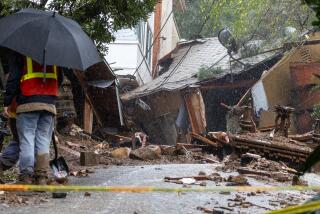How to Deduct Casualty Losses : Taxes: The IRS allows deductions for certain losses. But to qualify, the circumstances must be ‘sudden, unexpected or unusual.’
Nineteen eighty-nine was an especially bad year for casualty losses. Major events such as Hurricane Hugo and the San Francisco earthquake caused multibillion-dollar losses. But millions of taxpayers with less spectacular “sudden, unexpected or unusual” casualty losses can also claim deductions on their income tax returns.
Fire. Tornado. Theft. Vandalism. Broken water pipes. Earthquake. Windstorm. Hail damage. Accident. Hurricane. Flood. These are some of the major causes of deductible casualty losses.
Business casualty losses are fully deductible. However, only net uninsured personal casualty losses that exceed 10% of your adjusted gross income qualify for this deduction. If you are insured, but don’t want to file a claim for fear of insurance cancellation or any other reason, then you cannot claim a casualty loss deduction.
To illustrate how the personal casualty-loss deduction works, suppose your adjusted gross income is $50,000, and you had a $20,000 fire loss, but insurance only paid $12,000 of your repair costs.
Of your $8,000 uninsured loss, $5,000, or 10%, of your $50,000 adjusted gross income is not deductible, leaving a $3,000-casualty loss deduction. However, the first $100 of each casualty loss event is non-deductible, so your net deduction would be $2,900.
The cause of the loss must be “sudden, unexpected or unusual.” For example, termite damage to your home is usually not deductible because it occurs very slowly, often over many years. However, if you can prove that your termites worked very fast within just a few months, several Tax Court decisions have allowed the losses.
Other non-qualifying slow-damage examples include Dutch elm tree disease, erosion, well contamination, carpet beetles, dry rot, normal wear and tear and old age. However, if a qualifying event causes the loss, then a casualty loss may result. For example, if a flash flood causes your rotted front porch to collapse, then you have a deductible casualty loss.
Because casualty losses are often large, IRS auditors love to audit these deductions. Taxpayers should be prepared with solid proof of loss, such as police reports, photos, appraisals, repair bills, receipts, insurance settlements and other evidence. Your personal estimate of the before and after valuation or replacement cost is usually insufficient.
In addition to the 10% of adjusted gross income limit for personal, non-business casualty losses, any insurance settlement and the $100 per event floor must be subtracted when calculating the deduction. Use IRS form 4684 and itemize the loss on Schedule A of your federal tax returns.
The direct casualty loss, however, cannot exceed your adjusted cost basis in the property. But indirect costs, such as temporary housing, moving costs, legal expenses, crop damage and property protection fees also are deductible.
If your loss deduction eliminates your 1989 income tax, you can carry any excess loss back to 1986, 1987 and 1988 for a tax refund, then forward up to 15 years until the loss is completely offset by your taxable income.
More to Read
Inside the business of entertainment
The Wide Shot brings you news, analysis and insights on everything from streaming wars to production — and what it all means for the future.
You may occasionally receive promotional content from the Los Angeles Times.









